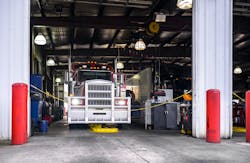In the past several years, shop bays have been bursting at the seams to keep trucks on the road. This was a combination of high demand for freight and fleets operating older trucks due to supply chain issues. Everyone was so busy focusing on getting trucks back on the road as quickly as possible that they probably did not spend a lot of time understanding shop productivity, efficiency, and proficiency.
Things seem to have calmed down some. OEMs are working hard to produce more trucks, and freight demand has slowed a bit. Now seems like a good time to re-evaluate shop performance.
As with any evaluation, the first step is collecting data. This will help you determine how well your shop—or that of your outside service provider—and the technicians in those shops are performing.
The best evaluations are based on consistent data, so if you are not already using Vehicle Maintenance Reporting Standards (VMRS), you might want to consider doing so. If you don't want to use VMRS, make sure you have some kind of consistency in the way you identify repairs so that you are comparing similar data when looking at how proficient your shop is with something like replacing brake shoes, for example.
See also: When is the ideal time to replace an asset?
You also need to make sure you are collecting data from every service event, whether that is a preventive maintenance service, scheduled repair, or a repair following a breakdown.
Once you have all your data, you can look at things like:
- How much time are the technicians spending diagnosing a problem?
- How much time does it take from when a diagnosis is made until the truck is in a bay and the tech is beginning the repair?
- How long are repairs taking? You can use standard repair times (SRTs) as a good indicator of how you are doing compared to these averages.
- On which repairs are techs exceeding SRTs? This is an indication that it is time to retrain or look at the way you assign jobs. Are you matching technician skill sets with each repair?
- How often are repairs delayed because parts are unavailable? I suggest you dig deeper here. Are you not stocking the right parts or are parts delayed because of national back orders? The in-house inventory issue is fixable.
- How often is a given truck in the shop between preventive maintenance services? The goal is to not see trucks between PMs. If trucks are coming in frequently between PM services, it may be time to give a refresher course in conducting a proper PM inspection.
- What percentage of repairs are returning for rework? Too many returns could mean that you need to ramp up training for certain problems.
- How long is it taking to get authorization for additional work? Are you slowing down the repair process at your outside service provider because you are not promptly approving additional repair work?
Analyzing this information will allow you to make improvements in your own shop or allow you to talk with your outside service providers about the areas in which you would like to see them make improvements. The end result will be a more productive and efficient maintenance and repair process.
About the Author
Jane Clark
Senior VP of Operations
Jane Clark is the senior vice president of operations for NationaLease. Prior to joining NationaLease, Jane served as the area vice president for Randstad, one of the nation’s largest recruitment agencies, and before that, she served in management posts with QPS Companies, Pro Staff, and Manpower, Inc.
